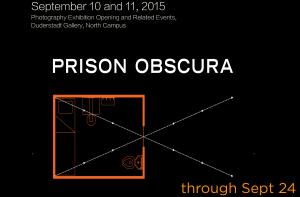Carceral Visions: The Prison as Image/Object/Limit

- Pete Brook, Curator and Writer, prisonphotography.org
- Amanda Alexander (Law)
- Reuben Miller (Social Work)
- Carol Jacobsen (Art, Women's Studies)
- Ruby Tapia (Women's Studies, English)
- Heather Ann Thompson (Afroamerican and African Studies, Residential College)

This symposium will feature remarks by Prison Obscura curator Pete Brook, and a roundtable discussion with U-M faculty members.
PRISON OBSCURA SHEDS LIGHT ON THE PRISON-INDUSTRIAL COMPLEX
No country incarcerates a higher percentage of its population than the United States. In fact, more than 2.2 million people are currently locked up in the U.S. – a number that’s more than quadrupled since 1980. But sadly, the lives lived behind bars are all too often invisible to those on the outside. Prison Obscura, curated by Pete Brook, sheds light on such experiences and the prison-industrial complex as a whole by showcasing rarely seen surveillance, evidentiary, and prisoner-made photographs. The exhibit, which runs at UM’s Duderstadt Gallery from the evening of September 10th to September 24th, 2015, encourages visitors to ask why tax-paying, prison-funding citizens rarely get the chance to see such images, and what roles such pictures play for those within the system.
Alyse Emdur’s collected letters and prison visiting room portraits from across the nation and Robert Bumpert’s recorded audio stories from within the San Francisco jail system provide an opportunity to see, read, and listen to subjects in the contexts of their incarceration. Juvenile and adult prisoners in different workshops led by Steve Davis, Mark Strandquist, and Kristen S. Wilkins perform for the camera, reflect on their past, describe their memories, and self-represent through photographs. Prison Obscura also features work made in partnership with the City of Philadelphia Mural Arts Program.
The exhibit moves between these intimate portrayals of life within the prison system to more expansive views of legal and spatial surveillance in works like Josh Begley’s manipulated Google Maps’ API code and Paul Rucker’s animated videos, which offer a “celestial” view of the growth of the prison system. Prison Obscura builds the case that Americans must come face to face with these images to grasp the proliferation of the U.S. prison system and to connect with those it confines.
Pete Brook is a Portland, Oregon-based freelance wrier and curator interested in social justice and the politics of visual culture. He writes and edits Prison Photography, a website that analyzes imagery produced within, and about, prisons, with a focus on the American prison-industrial complex. Prison Photography has been recognized as one of the best photography blogs by LIFE.com, The British Journal of Photography, and The Daily Beast. Brook holds a masters degree in art history from the University of St. Andrews and a master’s degree in art gallery and museum studies from University of Manchester. He has curated shows for Seattle’s Vermillion Gallery, Holland’s Noorderlicht Gallery, New York’s Photoville, and Belgrade’s Kulturni Cantar Belgrada. Brook writes regularly for Raw File, the WIRED photography blog, and is currently working on a book about the history of prison photography, which will be published by Silas Finch.
Prison Obscura and related events are sponsored by the Departments of Women’s Studies and English, the Institute for Research on Women and Gender, and the Prison Creative Arts Program.
For more information about the Prison Obscura exhibition at UM and related programming, contact Ruby Tapia, Associate Professor of English and Women’s Studies, at rtapia@umich.edu.
Prison Obscura is a traveling exhibition made possible with the support of the John B. Hurford ‘60 Center for the Arts and Humanities and Cantor Fitzgerald Gallery at Haverford College, Haverford, PA.
